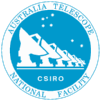| | 93 | [[Image(cx167_example_plot6.png)]] |
| | 94 | |
| | 95 | Not perfect, but it is good enough for now. |
| | 96 | |
| | 97 | The next step is where CABB reduction really differs from that of the old correlator. We need to determine |
| | 98 | whether we want to attack the dataset as a whole, working with all 2 GHz of bandwidth simultaneously, or |
| | 99 | do we want to "divide and conquer" by splitting the band into chunks similar to those output by the old |
| | 100 | correlator and that we know will work fine with MIRIAD? |
| | 101 | |
| | 102 | In this example we will look at how to proceed in both directions, but we will go through the "divide and |
| | 103 | conquer" (DAC) procedure first. |
| | 104 | |
| | 105 | To begin the DAC procedure, we use the new CABB `uvsplit` to split the visibility file, not only based on |
| | 106 | source, but into fixed bandwidth chunks. Since we know that 128 MHz bandwidth works in MIRIAD, we choose this |
| | 107 | for `uvsplit`: |
| | 108 | |
| | 109 | `uvsplit vis=cx167.uv select=-auto,-ant(6) maxwidth=0.128` |
| | 110 | |
| | 111 | This produces visibility sets for 1934-638, 0515-674 and rnovalmc, at centre frequencies (in MHz) of |
| | 112 | 4540, 4668, 4796, 4924, 5052, 5180, 5308, 5436, 5564, 5692, 5820, 5948, 6076, 6204, 6332 and 6460; a total |
| | 113 | of 16 bands (16 x 128 MHz = 2048 MHz, the actual bandwidth of CABB). |
| | 114 | |
